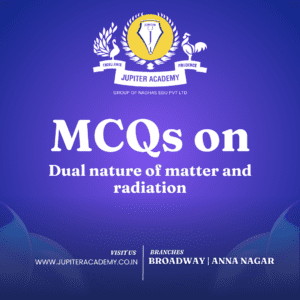Advisory and Instructions on Updation of Aadhaar Card/ UDID Card/...
Read More

Dual Nature of Matter and Radiation MCQs in NEET Exam
The dual nature of matter and radiation is an important chapter in physics for the NEET exam.
It is a relatively new chapter, having been introduced in the NEET syllabus in 2013. However, it has been a popular topic in the exam ever since, with questions being asked on it every year.
The chapter covers the wave-particle duality of matter and radiation, which is the idea that all matter and radiation can exhibit both wave-like and particle-like properties. This is a complex concept, but it is essential for understanding many aspects of physics, such as the photoelectric effect, matter waves, and diffraction.
The dual nature of matter and radiation is a relatively heavy-weight chapter in the NEET physics syllabus, with a weightage of around 4-5%.
This means that you should make sure to study this chapter thoroughly if you want to do well in the exam.
Here are some of the important topics in the dual nature of matter and radiation chapter that you should focus on for the NEET exam:
- Photoelectric effect
- Einstein’s photoelectric equation
- Matter waves
- Davisson-Germer experiment
- De Broglie wavelength
- Wave-particle duality
You should also practice solving a good number of questions on this chapter from previous NEET papers. This will help you get a feel for the kind of questions that are asked and the level of difficulty.
NEET (National Eligibility cum Entrance Test) level multiple-choice questions on the dual nature of matter and radiation:
**Question 1:**
Which of the following phenomena cannot be explained using the dual nature of matter and radiation?
a) Photoelectric effect
b) Diffraction of light
c) Reflection of light
d) Compton scattering
**Answer 1:**
c) Reflection of light
**Question 2:**
The phenomenon of photoelectric emission provides evidence for the particle nature of:
a) Electromagnetic waves
b) Light waves
c) X-rays
d) Electrons
**Answer 2:**
d) Electrons
**Question 3:**
The work function of a material is the minimum energy required to:
a) Emit electrons from the surface of the material
b) Absorb photons
c) Reflect light
d) Conduct electricity
**Answer 3:**
a) Emit electrons from the surface of the material
**Question 4:**
When electrons are accelerated through a potential difference V, their de Broglie wavelength:
a) Increases with V
b) Decreases with V
c) Remains constant
d) Depends on the speed of the electrons
**Answer 4:**
a) Increases with V
**Question 5:**
The de Broglie wavelength of a particle is inversely proportional to its:
a) Momentum
b) Mass
c) Energy
d) Charge
**Answer 5:**
a) Momentum
**Question 6:**
The minimum energy required to emit photoelectrons from a material depends on the:
a) Frequency of incident light
b) Intensity of incident light
c) Amplitude of incident light
d) Polarization of incident light
**Answer 6:**
a) Frequency of incident light
**Question 7:**
Which of the following experiments confirms the wave nature of particles?
a) Millikan oil-drop experiment
b) Photoelectric effect
c) Davisson-Germer experiment
d) Compton scattering
**Answer 7:**
c) Davisson-Germer experiment
**Question 8:**
The wavelength of an electron (de Broglie wavelength) is inversely proportional to its:
a) Velocity
b) Kinetic energy
c) Mass
d) Charge
**Answer 8:**
b) Kinetic energy
**Question 9:**
If the energy of a photon is doubled, its wavelength will:
a) Double
b) Halve
c) Remain unchanged
d) Become zero
**Answer 9:**
b) Halve
**Question 10:**
Which of the following statements about the dual nature of matter and radiation is correct?
a) Only electrons exhibit both wave-like and particle-like behavior.
b) Both light and matter exhibit only wave-like behavior.
c) Both light and matter can exhibit both wave-like and particle-like behavior.
d) Matter exhibits only wave-like behavior.
**Answer 10:**
c) Both light and matter can exhibit both wave-like and particle-like behavior.
Feel free to ask if you need more questions or explanations for any of these questions!
Here are some JEE Mains level multiple-choice questions on the dual nature of matter and radiation:
**Question 1:**
Which of the following phenomena can be explained using the dual nature of matter and radiation?
a) Photoelectric effect
b) Ohm’s law
c) Kirchhoff’s law
d) Snell’s law
**Answer 1:**
a) Photoelectric effect
**Question 2:**
In the photoelectric effect, if the frequency of incident light is increased while keeping the intensity constant, the kinetic energy of emitted electrons will:
a) Decrease
b) Increase
c) Remain constant
d) Depend on the work function of the material
**Answer 2:**
b) Increase
**Question 3:**
The threshold frequency for the photoelectric effect depends on:
a) Intensity of incident light
b) Wavelength of incident light
c) Speed of emitted electrons
d) Work function of the material
**Answer 3:**
d) Work function of the material
**Question 4:**
The de Broglie wavelength of a particle with momentum p is given by:
a) λ = h / p
b) λ = p / h
c) λ = h * p
d) λ = p * h
**Answer 4:**
a) λ = h / p
**Question 5:**
Electrons are accelerated through a potential difference V. If the de Broglie wavelength associated with these electrons is increased, what happens to the potential difference required?
a) Increases
b) Decreases
c) Remains the same
d) Becomes zero
**Answer 5:**
a) Increases
**Question 6:**
Which of the following particles exhibits both particle-like and wave-like behavior?
a) Electrons
b) Protons
c) Neutrons
d) Photons
**Answer 6:**
a) Electrons
**Question 7:**
The phenomenon of diffraction is associated with the wave nature of:
a) Electromagnetic waves
b) Sound waves
c) Particle waves
d) All of the above
**Answer 7:**
d) All of the above
**Question 8:**
Which of the following experiments supports the wave nature of particles?
a) Photoelectric effect
b) Compton scattering
c) Davisson-Germer experiment
d) Zeeman effect
**Answer 8:**
c) Davisson-Germer experiment
**Question 9:**
The energy of a photon is directly proportional to its:
a) Frequency
b) Wavelength
c) Momentum
d) Speed
**Answer 9:**
a) Frequency
**Question 10:**
Which of the following statements is true regarding the dual nature of matter and radiation?
a) Electrons are only particles and do not exhibit wave-like behavior.
b) Photons are only waves and do not exhibit particle-like behavior.
c) Both matter and radiation can exhibit both particle-like and wave-like behavior.
d) Neither matter nor radiation exhibits particle-like or wave-like behavior.
**Answer 10:**
c) Both matter and radiation can exhibit both particle-like and wave-like behavior.
Feel free to ask if you need more questions or explanations for any of these questions!
Here are some tips for studying the dual nature of matter and radiation chapter for the NEET exam:
- Start by understanding the basic concepts of wave-particle duality.
- Read the relevant sections of your physics textbook carefully.
- Solve practice questions from previous NEET papers.
- Join a study group or find a tutor who can help you with this chapter.
- Make sure to review the chapter regularly so that the concepts stay fresh in your mind.
The dual nature of matter and radiation is a challenging chapter, but it is also an important one. By following these tips, you can make sure that you are well-prepared for this chapter on the NEET exam.
NEET 2025: OMR Sheet Filling Tips to Avoid Mistakes
NEET 2025: OMR Sheet Filling Tips to Avoid Mistakes Preparing...
Read MoreTN Medical 2024 Counseling: Extension of Round 2 for MBBS & BDS
TN Medical 2024 Counseling: Extension of Round 2 for MBBS...
Read MoreDual Nature of Matter and Radiation MCQs in NEET Exam Dual Nature of Matter and Radiation MCQs in NEET Exam Dual Nature of Matter and Radiation MCQs in NEET Exam Dual Nature of Matter and Radiation MCQs in NEET Exam Dual Nature of Matter and Radiation MCQs in NEET Exam Dual Nature of Matter and Radiation MCQs in NEET Exam v Dual Nature of Matter and Radiation MCQs in NEET Exam Dual Nature of Matter and Radiation MCQs in NEET Exam Dual Nature of Matter and Radiation MCQs in NEET Exam Dual Nature of Matter and Radiation MCQs in NEET Exam Dual Nature of Matter and Radiation MCQs in NEET Exam Dual Nature of Matter and Radiation MCQs in NEET Exam Dual Nature of Matter and Radiation MCQs in NEET Exam Dual Nature of Matter and Radiation MCQs in NEET Exam






